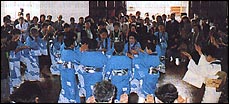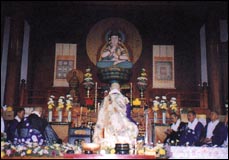![]()
|
In Commemoration of 60 Years of South American Missionary Work:
Visiting Various Missionary Areas
|
The Heart of the Mandala by Ryuko Suyama, Ryusen-ji temple, Kanagawa Prefecture  People of different languages and ages harmonizing thier hearts and dancing together. A long time ago, I heard sayings that went something like the following: "A candle slowly but eventually goes out after you burn it for a while. But if you take its flame and keep moving its flame to a succession of candles, the flame will never be extinguished." "The flame of candle can brightly light up a room." "There were people who were marooned on a mountain during winter and they dug for themselves a small cavern. They lit their cavern with a single candle. They derived warmth from it while they encouraged each other and thus they were saved." There are those who live on the other side of the Earth who have been reverently keeping the torch of Odaishi-sama's teaching lit in their hearts. They have been using the torch to give support to their hearts, as they encounter difficulty in their lives. They have the simple kindness that is never imposing, which we have forgotten, being inundated with the hustle and bustle of life. They have peaceful faces and a lovely language. It is those in Brazil who are still nurturing this kindness to this day. I believe that Odaishi-sama has always been watching over them. After the ceremonies within the main hall were finished at Kongo-ji on the outskirts of Sao Paulo, those who participated in the South American missions trip formed a large circle with our Brazilian friends and danced the "Daishi Ondo" and "Iroha Bon Uta." During that time I was taking pictures from above the stage and I was overcome with the feeling of the "heart of Mandala." while I was watching the dancing forms of those with different languages, ages, appearances and ways of thinking. I couldn't help but feel at that time the smiling presence of Odaishi-sama standing in the center of the circle. Children of those who have gone from Japan to Brazil are now of the age of becoming active in society in all its various facets. I have come to the realization this trip that Goeika, Religious Dance, Flower Arrangement, etc. are ways to pass on Daishi's teachings effectively, breaking the language barrier ( I was able to appreciate the importance of linguistic ability during this overseas missionary trip.) I keep wondering about ways of spreading widely Daishi's teachings by first and second generation Japanese-Brazilians to upcoming generations. I want to relay that which can not be expressed with words and also that which must be expressed with words are both vehicles. I unceasingly desire for the warm torch of Daishi's teachings to be lit eternally. |
Page 3
Previous | 1| 2| 3 | 4| Next
©1999 Koyasan Shingon-shu
